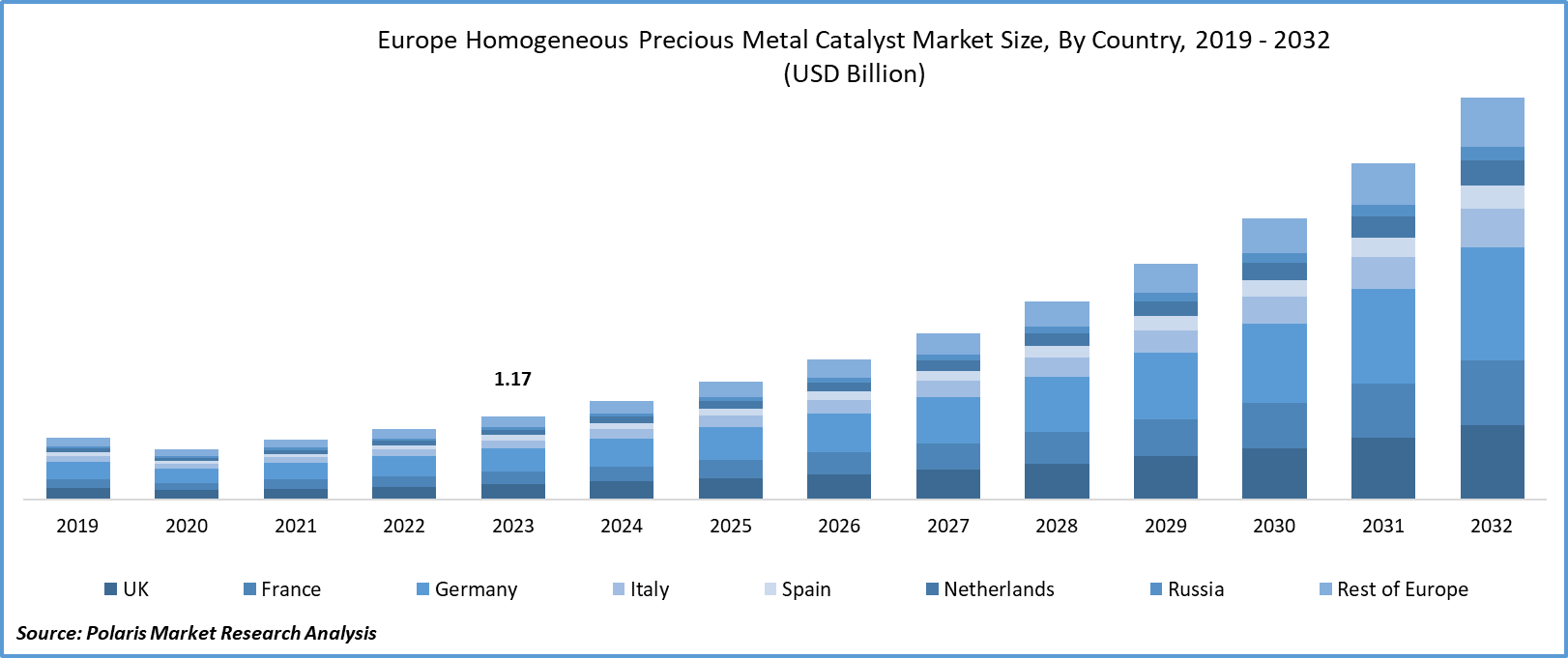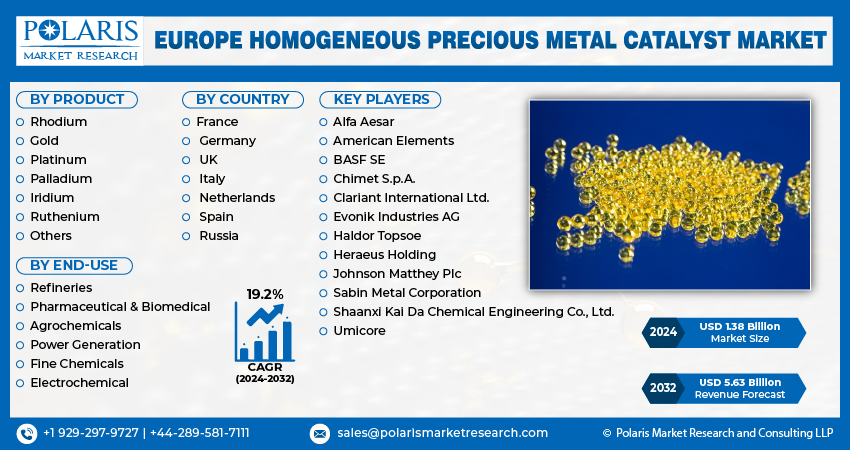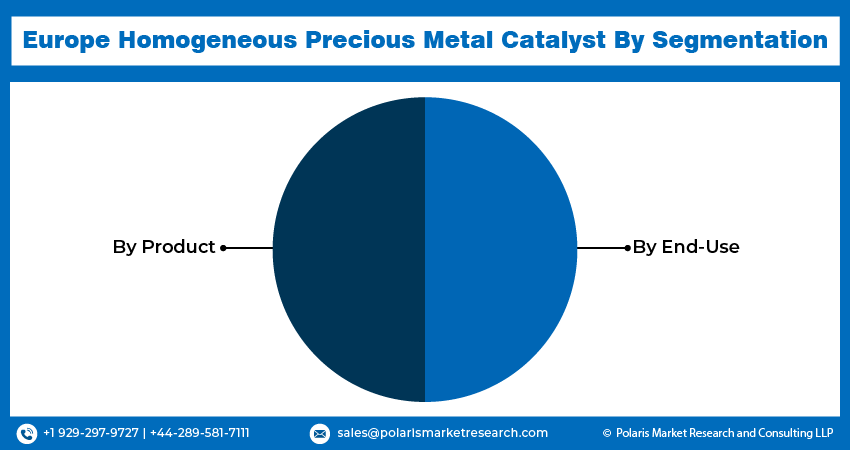
Europe Homogeneous Precious Metal Catalyst Market Share, Size, Trends, Industry Analysis Report, By End-Use (Refineries, Pharmaceutical & Biomedical, Agrochemicals, Power Generation, Fine Chemicals, Electrochemical); By Product; By Region; Segment Forecast, 2024- 2032
- Published Date:Feb-2024
- Pages: 113
- Format: PDF
- Report ID: PM4557
- Base Year: 2023
- Historical Data: 2019 – 2022
Report Outlook
Europe's Homogeneous Precious Metal Catalyst Market size was valued at USD 1.17 billion in 2023. The market is anticipated to grow from USD 1.38 billion in 2024 to USD 5.63 billion by 2032, exhibiting a CAGR of 19.2% during the forecast period
Europe Homogeneous Precious Metal Catalyst Market Overview
In numerous chemical processes, particularly those demanding high selectivity or intricate transformations, precious metal catalysts find frequent application. Within this domain, metals such as platinum, rhodium, palladium, iridium, and ruthenium are commonly employed in homogeneous catalysts, leveraging their unique electrical and structural characteristics for remarkable catalytic performance.
Homogeneous precious metal catalysts play a vital role in various sectors, including petrochemicals, fine chemicals, pharmaceuticals, and specialty chemicals. Their application extends to diverse chemical processes such as hydrogenation, carbon-carbon bond formation, oxidation, and asymmetric synthesis. Homogeneous precious metal catalysts offer several advantages, operating effectively under straightforward reaction conditions, often at room temperature and pressure. These catalysts exhibit outstanding selectivity, promoting specific reactions while inhibiting the generation of undesirable byproducts. The ease of separation and recovery from the reaction mixture, facilitated by homogeneous catalysts, contributes to increased efficiency and reduced waste.
The anticipated expansion in the homogeneous precious metal catalysts market is credited to the increasing chemical sales and manufacturing globally, particularly in European countries. This growth market trend is expected to act as a catalyst for the market's development in the near future.
Germany holds the largest for homogeneous precious metal catalysts market in Europe, experiencing homogeneous precious metal catalysts market growth attributed to the robust presence of end-user industries of the product, including power generation, pharmaceuticals, and chemicals. The country's market growth share is further fueled by increasing investments in setting up new refineries and the expansion of existing ones despite Germany's limited natural resources.

To Understand More About this Research: Request a Free Sample Report
By the European homogeneous precious metal catalyst market trend, Germany stands out as a significant market for homogeneous metal catalysts, driven primarily by their expanding application, including pharmaceuticals, biomedical manufacturing, and fine chemicals. Europe's homogeneous precious metal catalyst market share in end-use segments like refineries still needs to grow in the country due to limited domestic natural gas and oil production capacity, leading to heavy dependence on imports. Germany exclusively imports natural gas through cross-border pipelines, creating substantial growth potential for the petroleum refinery industry in the years ahead to reduce reliance on other European countries.
Germany holds the top position among the world's leading chemical producers, As per CEFIC. The substantial presence of key manufacturers, including Bayer AG, BASF SE, and Henkel AG, Evonik Industries, among others influences the growth of the chemical market in Germany. These market players command significant shares in the global fine chemicals industry, contributing to the country's prominence in the global chemical manufacturing landscape.

Europe Homogeneous Precious Metal Catalyst Market Dynamics
Market Drivers
Growing preference for specialty chemicals bolstering the growth of the homogeneous coating market.
Homogeneous catalysts featuring precious metals like palladium, platinum, and gold have become essential instruments in the synthesis of fine chemicals owing to their distinctive catalytic properties. As industries increasingly prioritize the production of high-value and specialized chemical compounds, these homogeneous precious metal catalysts play a crucial role in facilitating efficient, selective, and sustainable synthesis processes. This positions them as key contributors to the growth of the fine chemicals sector.
So, the European market for homogeneous precious metal catalysts is experiencing growth driven by the industry trend of escalating demand for fine chemicals in diverse industries such as electronics, agrochemicals, pharmaceuticals, and cosmetics. The catalytic efficiency, versatility, and sustainability characteristics of homogeneous precious metal catalysts establish them as indispensable elements in the synthesis of high-value and specialized chemical compounds. With industries evolving and innovating, the sustained growth in demand for homogeneous precious metal catalysts is anticipated, underscoring their pivotal role in advancing fine chemical production and contributing to the development of innovative products across various sectors.
Market Restraints
Expensive Nature of Precious Metals is likely to hamper the growth of the market.
These catalysts heavily rely on metals like platinum, gold, and palladium; their production costs are inherently elevated. The scarcity and market volatility of precious metals contributes to the overall expense of manufacturing Homogeneous Precious Metal Catalysts, rendering them less competitive compared to alternative catalyst technologies.
This cost challenge poses a hindrance to widespread adoption, particularly in industries where cost-effectiveness is of utmost importance. Industry stakeholders need to address this obstacle by exploring innovative methods for metal recovery and recycling, investing in research and development to reduce metal usage, and exploring alternative catalytic materials. Effectively tackling the high cost of precious metals is crucial for the homogeneous precious metal catalyst market to improve its economic feasibility, foster broader market acceptance, and facilitate sustained global market growth.
Report Segmentation
The market is primarily segmented based on product, end-use, and region.
|
By Product |
By End-Use |
By Country |
|
|
|
To Understand the Scope of this Report: Speak to Analyst
Europe Homogeneous Precious Metal Catalyst Market Segmental Analysis
By Product Analysis
- In 2023, the palladium segment solidified its prominence, holding a significant share. Essential platinum compounds like Karstedt’s catalyst, cisplatin ([PtCl2(NH3)2]), and hexachloroplatinic acid (H2[PtCl6]) played pivotal roles across various applications. Within Europe, platinum-based catalysts played a vital role in hydrosilylation reactions. Karstedt’s catalyst, in particular, found favor in applications such as paper coating for bottling and packaging, especially in hydrosilylation reactions, where it exists in trace amounts measured in parts per million (ppm). The presence of this catalyst in trace amounts presents challenges for economically viable platinum recovery from used catalysts. Moreover, Karstedt’s catalyst is employed in complexes alongside vinyl siloxane ligands.
Homogeneous palladium catalysts are widely utilized in applications involving hydroesterification reactions. A notable instance is Lucite International, utilizing the catalyst for the production of MMA from ethylene, carbon monoxide, and methanol. Dow Chemical employs a similar technology for octene production, relying on the palladium triphenylphosphine complex as a catalyst.
- Homogeneous metal catalysts based on rhodium find application in reactions necessitating lower temperatures and pressures, such as hydroformylation. Key precursors for these reactions include (acetylacetonate) dicarbonyl rhodium (I), (acetylacetonate)carbonyl (triphenylphosphine)rhodium(I), and rhodium acetate. Wilkinson’s catalyst, [RhCl (PPh3)3], stands out as one of the frequently employed homogeneous palladium catalysts.
By End-Use Analysis
- In the forecast period, the European homogeneous precious metal catalyst market trends were predominantly led by the refineries segment. This notable share can be attributed to the presence of numerous major refineries in Europe, indicating substantial potential for market expansion. Homogeneous precious metal catalysts play a vital role in refineries by contributing to optimized and cost-effective oil production. As of 2021, approximately 78 mainstream refineries were operational in the European region. The recent upswing in oil production is expected to underscore the demand for homogeneous precious metal catalysts in the near future.
- Homogeneous precious metal catalysts are used widely in the pharmaceutical and biomedical sectors to enhance reaction yields, promote environmental sustainability, and improve cost-effectiveness, thereby enhancing overall production profitability. The market size has experienced progress in terms of research and development focused on catalyst recovery in pharmaceutical and biomedical processes. This aspect is particularly challenging compared to heterogeneous catalysts, such as nanofiltration recovery. The advancements in catalyst recovery are expected to contribute to the increased adoption of these catalysts in the market.
Europe Homogeneous Precious Metal Catalyst Market Regional Insights
Germany dominated the European homogeneous Precious Metal Catalyst market with the largest market share in 2023
This substantial share is attributed to Germany's prominent chemical industry, including a significant presence in the pharmaceutical sector, making it a key contributor in Europe. According to the European Chemical Industry Council, Germany's chemical industry, inclusive of pharmaceuticals, ranked as the third-largest in Europe, generating Euro 227.1 billion in 2021.
Furthermore, Germany's strong emphasis on research and development in the chemical and pharmaceutical sector is evident in its significant investment of Euro 13.2 billion. These numbers highlight the nation's commitment to advancing research and development initiatives within these industries. Together, these factors contribute to the considerable influence of the pharmaceutical industry, leveraging the use of precious metal catalysts (PGM). With their distinctive properties, PGM catalysts are aptly positioned to enhance market size, foster innovation, and uphold the high-quality standards required by the dynamic pharmaceutical sector in Germany and other prominent European nations.
The existence of a strong product-manufacturing foundation in the UK, France, and Germany is anticipated to impact market growth positively. The European Commission, with the primary goal of fostering the utilization and production of natural ingredients, has implemented the Horizon 2021 Strategy across various sectors, including chemicals, personal care, automotive, and energy.
Competitive Landscape
The European homogeneous Precious Metal Catalyst market size is fragmented and is anticipated to witness competition due to several players' presence. Major service providers in the market are constantly upgrading their technologies to stay ahead of the competition and to ensure efficiency, integrity, and safety. These players focus on partnership, product upgrades, and collaboration to gain a competitive edge over their peers and capture a significant market share.
Some of the major players operating in the global market include:
- Alfa Aesar
- American Elements
- BASF SE
- Chimet S.p.A.
- Clariant International Ltd.
- Evonik Industries AG
- Haldor Topsoe
- Heraeus Holding
- Johnson Matthey Plc
- Sabin Metal Corporation
- Shaanxi Kai Da Chemical Engineering Co., Ltd.
- Umicore
Recent Developments
- In October 2023, Evonik officially announced a formal agreement to participate in the development, scaling up, and production of specialized bed-fixed catalysts tailored for the implementation of Hydrogenious LOHC Technologies' proprietary liquid organic hydrogen carrier (LOHC) technology. This innovative technology is based on benzyl toluene.
- In September 2023, Evonik Industries revealed its intentions to relocate and upgrade its precious metal powder catalyst production facility located in the Shanghai Chemical Industrial Park (SCIP). The primary aim of this endeavor is to strengthen the company's position and capabilities in the catalyst market.
- In July 2023, BASF completed the carve-out process for its mobile catalysts emissions and precious metal services business, officially establishing the independent legal entity named BASF Environmental Catalyst and Metal Solutions (ECMS). The decision to carve out this entity was initially announced in December 2021, with an expected completion timeline of 18 months.
Report Coverage
The Europe Homogeneous Precious Metal Catalyst market industry report emphasizes key regions across the globe to provide a better understanding of the product to the users. Also, the report provides market insights into recent developments and trends and analyzes the technologies that are gaining traction around the globe. Furthermore, the report covers an in-depth qualitative analysis pertaining to various paradigm shifts associated with the transformation of these solutions.
The report provides a detailed analysis of the market while focusing on various key aspects such as competitive analysis, product, end-use, and futuristic growth opportunities.
Europe Homogeneous Precious Metal Catalyst Market Report Scope
|
Report Attributes |
Details |
|
Market Size Value in 2024 |
USD 1.38 billion |
|
Revenue Forecast in 2032 |
USD 5.63 billion |
|
CAGR |
19.2% from 2024 – 2032 |
|
Base Year |
2023 |
|
Historical Data |
2019 – 2022 |
|
Forecast Period |
2024 – 2032 |
|
Quantitative Units |
Revenue in USD million/billion and CAGR from 2024 to 2032 |
|
Segments Covered |
By Product, By End-Use, By Region |
|
Country Scope |
France, Germany, UK, Italy, Netherlands, Spain, Russia |
|
Customization |
Report customization as per your requirements with respect to countries, regions, and segmentation. |
Navigate through the intricacies of 2024 Europe's homogeneous precious metal catalyst market with precision, thanks to the comprehensive statistics on market share, size, and revenue growth rate assembled by Polaris Market Research Industry Reports. This thorough analysis not only provides a glimpse into the historical context but also extends its reach with a market forecast outlook until 2032. Immerse yourself in the richness of this industry analysis by securing a complimentary PDF download of the sample report.
FAQ's
The global Europe Homogeneous Precious Metal Catalyst market size is expected to reach USD 5.63 billion by 2032
Key players in the market are Alfa Aesar, American Elements, BASF SE, Chimet S.p.A., Clariant International Ltd
Europe's Homogeneous Precious Metal Catalyst Market exhibiting a CAGR of 19.2% during the forecast period
The Europe Homogeneous Precious Metal Catalyst Market report covering key segments are product, end-use, and region.

